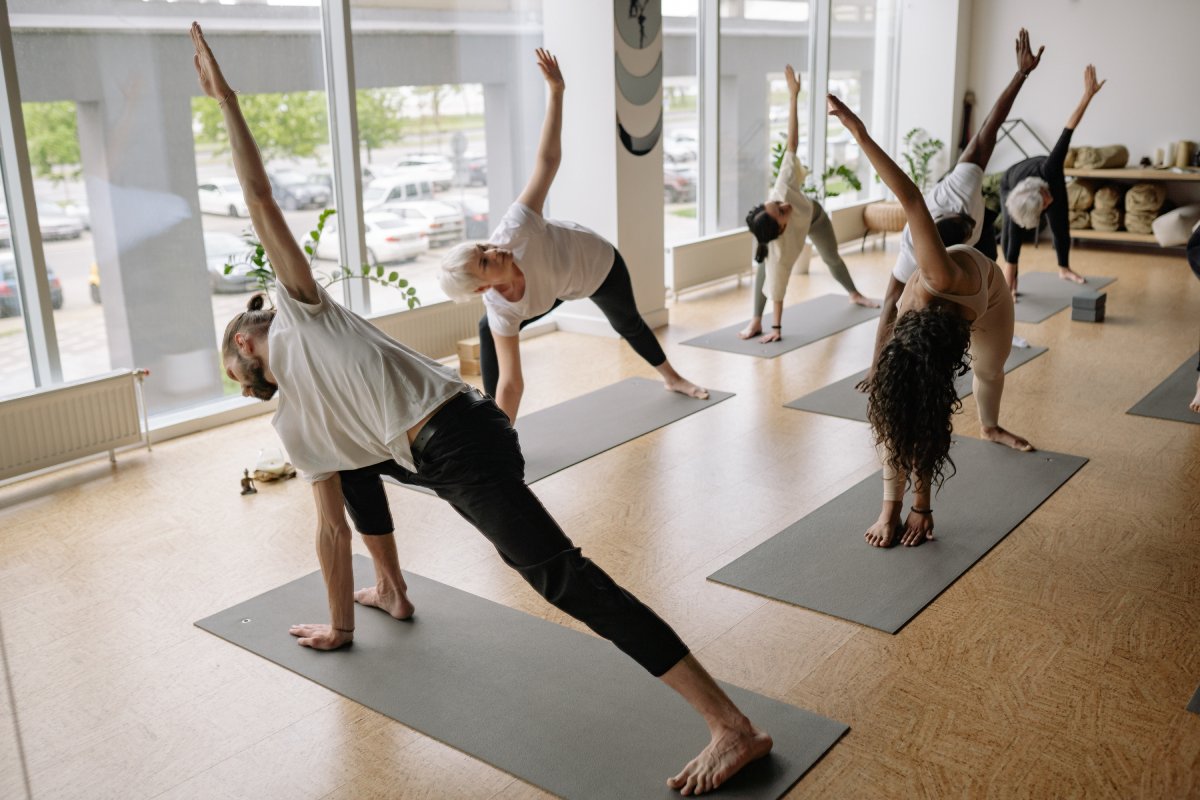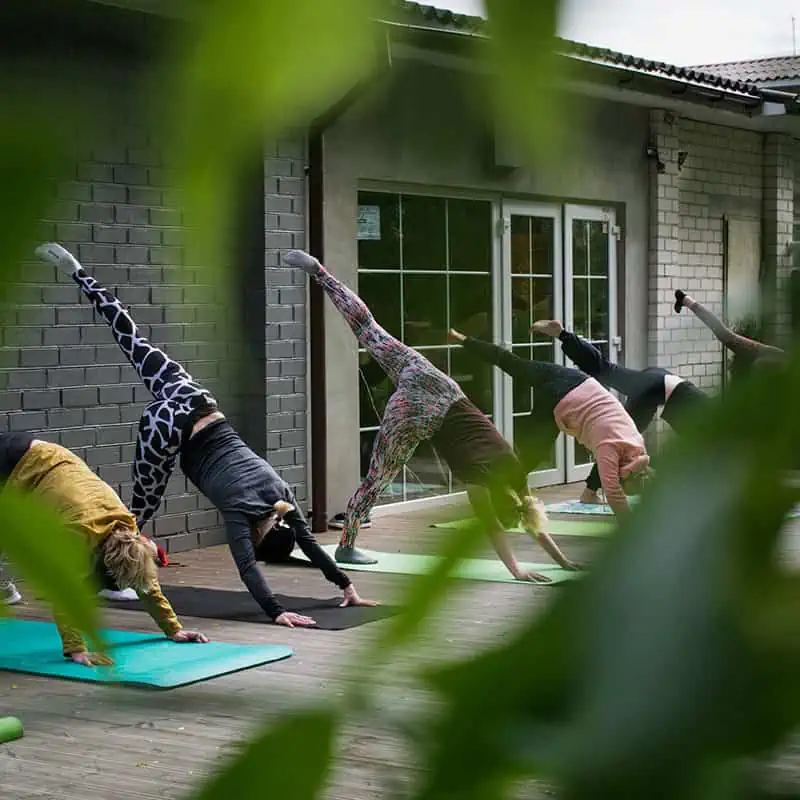Listen to this article:
Key Takeaway
Ashtanga Yoga, a dynamic and structured practice rooted in eight moral principles, offers a rigorous full-body workout and mental clarity, making it ideal for those seeking physical fitness and spiritual growth.
If you are seeking a full-body workout, inner cleansing, and a clear mind, the Ashtanga Primary Series could be perfect for integrating into your practice.
Also known as power yoga, Ashtanga Yoga is a school of yoga based on eight moral principles and a set of yoga poses. You perform this same sequence of poses in swift succession every time, aiming to merge each movement with deep breathing.
Like Bikram or hot yoga classes, this type of yoga requires discipline, flexibility, and stamina. It is more vigorous and intense than common Hatha yoga classes. However, it is also plenty accessible to beginners who want to advance their practice.
The most important philosophy behind this ancient practice is internal cleansing and calming the nervous system while cultivating a sense of spirituality. Whether you’re seeking an elevated consciousness or just a hardcore workout, Ashtanga is a challenging and rewarding practice with incredible mind and body benefits.
There are six series of Ashtanga classes, beginning with The Primary Series. This first series is the introduction for most students. It can be practiced daily for overall health and wellness.
So what poses and methods are included in the Ashtanga Primary Series? Where does it come from, and what are the benefits?
Let’s dig into everything you need to know about the Primary Series of Ashtanga Yoga.
Contents
Why Practice Ashtanga Yoga? Benefits of Ashtanga
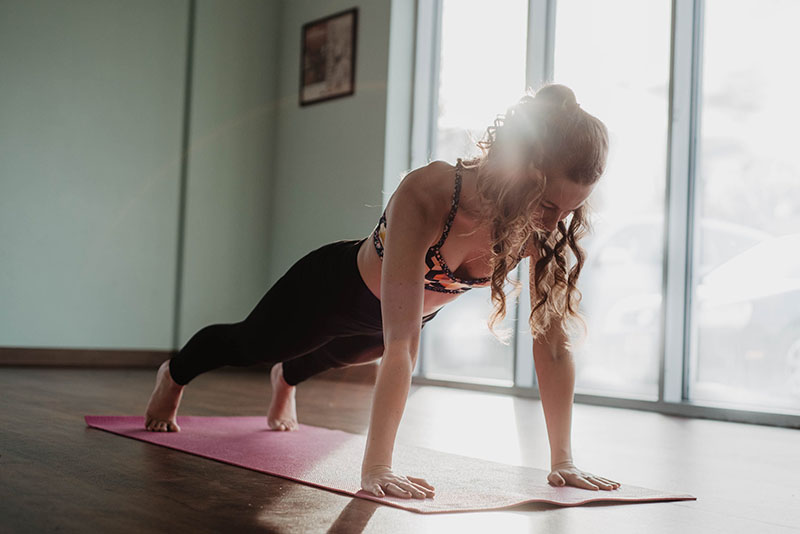
Ashtanga yogis are among the most advanced yogis in the world. There is an incredible amount of discipline, rigorous exercise, and intense focus required to perform the full six series of traditional Ashtanga.
While this school of thought has origins in a complex spiritual and healing practice, today many Western yogis embark on this journey specifically for physical fitness.
And there is no doubt about it: power yoga will get you in shape.
Even modified versions of the traditional sequence can take up to 90 minutes. You will break a sweat, torch some major calories, enjoy an intense stretch, and likely collapse on your mat at the end.
But the intense release and transformation many people experience from power yoga is what keeps them coming back.
So, is it worth it? These science-backed benefits of Ashtanga Yoga say a resounding yes!
A 2007 yoga study at the University of London found that a sample group of 22 completely beginner yogis experienced transformative benefits from practicing a 60-minute class of the Ashtanga Primary Series for 8 weeks.
Other studies have also discovered incredible mental health benefits for both children and adults.
The benefits of Ashtanga Yoga include:
- Greater flexibility and range of motion
- Reduced back pain
- Improved core strength and endurance
- Improved upper body strength
- Weight loss and reduced body fat
- Increased muscle tone
- Stress relief and a calmer mind
- Improved self-esteem
- Reduced symptoms of anxiety and depression
Needless to say, Ashtanga is truly therapeutic for the mind, body, and soul.
History of Ashtanga Yoga
It is said that Ashtanga Yoga was first documented by a sage named Vamana Rishi in the ancient text Yoga Korunta. The style originated in Mysore, India, and is now practiced by thousands of people around the world.
In the early 1900s, the teachings of Ashtanga were passed down through Guru Rama Mohan Brahmachari to Sri T. Krishnamacharya and later to Pattabhi Jois, who made the practice more widely available to the Western world.
Also known as Ashtanga Vinyasa Yoga, this dynamic practice is a combination of vinyasa, ujjayi pranayama, drishti, bandhas, mantras, and mudras. These Sanskrit words have specific meanings and functions in the Ashtanga tradition:
- Vinyasa: A flowing sequence of movement that coordinates regulated breathing with a sort of dance between poses (asanas) to keep the body in continuous motion.
- Ujjayi pranayama: This whisper-like breathing is a type of deep breath control sometimes known as “cobra breathing.” It circulates prana throughout the body by closing the mouth, constricting the throat, and practicing equal-duration inhales and exhales.
- Drishti: The focal gazing point used by Ashtanga yogis aims to create concentrated intention and help the body create balance. There are 9 different types of drishti that can be taught in Ashtanga.
- Bandhas: Internal “body locks” are muscular contractions of the pelvic floor and lower stomach to support the body during practice and aid in opening the energetic channels for prana to flow.
- Mantras: Sanskrit words or holy sounds are often repeated as mantras to help yogis become more deeply concentrated and enter a meditative state.
- Mudras: Specific hand gestures are symbolic and sacred means of placing the fingers in certain shapes to guide energy flows and change reflexes in the brain.
All of these practices work together to create harmony between the physical, energetic, emotional, and mental aspects of being human.
Ashtanga is based on an 8-fold path toward achieving a state of Samadhi, or spiritual enlightenment.
While we may not all feel like we’re on the path to enlightenment just yet, the immediate goal of an Ashtanga Yoga practice is simply to build prana in the body.
Prana is life force energy that pulses through all living things. In the body, the prana flows in a way that is similar to a central nervous system. The prana system is correlated with the 7 chakras (wheels of energy) and the 72,000 nadis (energy channels) that run throughout the body.
As you flow, stretch, bend, and breathe, these meridians and prana channels open up, simultaneously stimulating the digestive system, cardiovascular system, and parasympathetic nervous systems.
8 Limbs of Ashtanga
Ashtanga translates to “eight limbed yoga” (in Sanskrit, ashta means eight and anga means limb). The ancient book The Yoga Sutras of Patanjali outlines this “8-fold path” to enlightenment or inner purification.
The eight limbs of Ashtanga Yoga include:
- Yamas: The first limb is all about morals and ethics. These ethical standards about life are the foundation of living the way of a yogi. Similar to the “Golden Rule,” yamas teach practitioners to essentially “treat others the way you want to be treated.”. The 5 key yamas are ahimsa (nonviolence), satya (truthfulness), asteya (nonstealing), brahmacharya (continence), and apirgraha (noncovetousness). Modern-day Ashtangis interpret these yamas in different ways, but the most important thing to remember is that this yoga practice requires an essential moral component that fills your life both on and off the mat.
- Niyama: The second limb is based on self-discipline and spirituality. The 5 niyamas are saucha (cleanliness), samtosa (contentment), tapas (heat/fiery spiritual discipline), svadhyaya (studying oneself and the sacred scriptures), and isvara pranidhana (surrender to God or the Universe). Yogis may put these into practice through meditation practices, prayers, and journaling.
- Asanas: What we generally call “yoga” in the Western world is just one limb of the 8-fold path. These physical body postures were originally meant to strengthen and prepare the body for long hours of meditation.
- Pranayama: Deep breathwork is a core pillar of both yoga and meditation. The literal translation of pranayama is “life force extension” because yogis have long believed that deep breath control improves and lengthens your life. In Ashtanga Vinyasa, breathing is especially important to incorporate with movements between each asana.
- Pratyahara: The fifth yoga limb relates to the sense of control or withdrawal from external stimuli. This means paying close attention to our bodies and the present moment. Off the mat, this can also include observing one’s habits and cravings that may be interfering with personal growth.
- Dharana: Concentration is the limb that precedes meditation. While it can be challenging to concentrate in a world of distractions, this practice is designed to calm the mind and create both inner as well as outer balance.
- Dhyana: Meditation and contemplation are the hallmarks of the seventh limb of yoga. This ultimate state of fully quieting the mind may feel elusive to beginner meditators, however, it is a worthwhile goal to pursue if you aim to find higher levels of consciousness and inner peace. Remember that yoga is a process and we can’t expect ourselves to instantly reach a meditative state during our first flow.
- Samadhi: The final stage or goal of yoga is complete absorption into the Universal bliss. In other words, this is what happens when a meditator merges his or her focus with the profound realization of interconnectedness of the universe. While some may associate it with “enlightenment”, samadhi can also be seen as the simple experience of bliss and fulfillment.
As you can tell, both Jois and Patanjali intended for Ashtanga Yoga to encompass life far beyond the mat.
The Six Series of Ashtanga Yoga
The asana (physical) portion of traditional Ashtanga practice includes six series, each with different goals. The series themselves are set sequences of poses, mantras, and other practices that are repeated in chronological order the same every time:
- The Primary Series (Yoga Chikitsa) is yoga therapy or yoga for your health.
- The Intermediate Series or Second Series (Nadishodhana) is for purifying the nervous system.
- The Advanced Series (Sthira Bhaga) is all about centering your strength. It includes:
- Advanced A, or Third Series
- Advanced B, or Fourth Series
- Advanced C, or Fifth “Rishi” Series
- Advanced D, or The Sixth Series
In this article, we are focusing on the Primary Series, which is the most beginner-friendly and well-known sequence of Ashtanga.
Understanding the Ashtanga Primary Series
Yoga Chikitsa (योग चिकित्सा) is the Sanskrit term for this opening series of power yoga. It translates to “yoga therapy” and comprises of 7 core parts, beginning and ending with a mantra (a repetition of holy syllables).
You may recognize many poses in this initial series from common Vinyasa and Hatha yoga classes. Ashtanga and Vinyasa are often used simultaneously.
Like other styles, Ashtanga is meant to feel like a moving meditation. Integrating movement with breath key for an uninterrupted flow that can fully open up and align your chakras (energy channels in the body).
Part 1: Opening Mantra
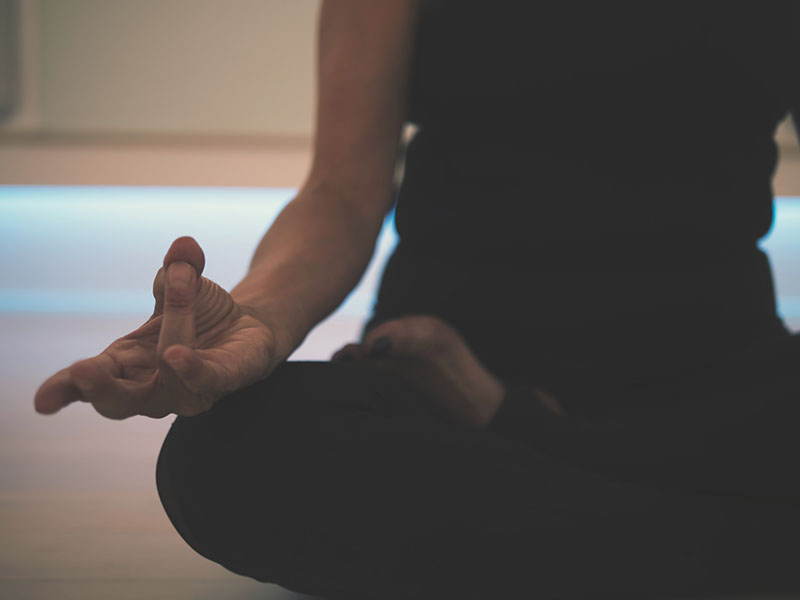
Traditional Ashtanga Yoga begins with an opening chant. These holy syllables hum on a frequency that
The purpose of chanting and reciting mantras in yoga is twofold: the intonation of vibratory sounds in your throat activates the chakras and may even positively impact your memory and attention.
At the same time, tuning into the listening side of a chant allows you to quiet the mind and contemplate the silence of the present moment.
The ancient opening mantra goes as follows (with English translations in parentheses):
“Om Vande gurunaam chaaranara vinde
(I bow to the lotus feet of the gurus)
Sandar shita swaatma sukhava bhode
(who awakens insight into the happiness of pure being)
Nishrey yase jaangalika yamane
(like the jungle healer, who brings great well-being)
Samsara haala hala moha shantye
(relief from delusion, the poison of Samsara)
Abahu purusha Karam
(the upper body having human form)
Shankha chakraasi dharinam
(holding a conch, discus, and sword)
Sahasra shirasam shvetam
(having a thousand branched heads of white light)
Pranamaami patanjalim
(I bow to Patanjali)
Om”
This mantra is used to catapult you into the present moment, express gratitude to the gurus and teachers who came before, and symbolize a surrender to the process.
Part 2: Surya Namaskar A (9 asanas) – Repeat 5 times
After the opening mantra, the Primary Series moves to a (likely) very familiar sequence of postures: Sun Salutation (Surya Namaskara A).
This Vinyasa flow includes 9 core asanas that are repeated 5 times in a cyclical nature. This flow aims to build heat in the body and begin to sync the breath with movement.
We have a full article that digs into all the details of this fundamental Sun Salutation, including step-by-step guide to each pose and its benefits.
For the Primary Series, here is the simple sequence:
- Prayer Pose (Pranamasana)
- Raised Arms Pose (Hasta Uttanasana)
- Hand to Foot Pose (Hasta Padasana)
- Equestrian Pose (Ashwa Sanchalanasana) – low lunge
- Plank Pose (Dandasana/Phalakasana)
- Eight Points Salute (Ashtanga Namaskar)
- Cobra Pose (Bhujangasana)
- Upward Facing Dog Pose (Urdhva Mukha Svanasana)
- Downward Facing Dog (Adho Mukha Svanasana)
- Equestrian Pose (Ashwa Sanchalanasana) – other side
- Hand to Foot Pose (Hasta Padasana) – other side
- Mountain Pose (Tadasana)
Part 3: Surya Namaskar B (17 asanas) – Repeat 5 times

After round A of sun salutations, the series moves into Surya Namaskar B. These sun salutations extend the flow of the first round but are a bit more challenging because they add Chair Pose and Warrior I into the flow, creating more leg strengthening and balance challenges.
- Mountain Pose (Tadasana)
- Chair Pose (Utkatasana)
- Standing Forward Bend (Uttanasana)
- Half Forward Bend Pose (Ardha Uttanasana)
- Plank Pose (Dandasana/Phalakasana)
- Eight Points Salute (Chaturanga)
- Upward Facing Dog Pose (Urdhva Mukha Svanasana)
- Downward Facing Dog (Adho Mukha Svanasana)
- Warrior I Pose (Virabhadrasana I)
- Plank Pose (Dandasana/Phalakasana)
- Eight Points Salute (Chaturanga)
- Upward Facing Dog Pose (Urdhva Mukha Svanasana)
- Downward Facing Dog (Adho Mukha Svanasana)
- Warrior I Pose (Virabhadrasana I) – other side
- Plank Pose (Dandasana/Phalakasana)
- Standing Forward Bend (Uttanasana)
- Eight Points Salute or “Four Limbed Staff Pose” (Chaturanga Dandasana)
- Upward Facing Dog Pose (Urdhva Mukha Svanasana)
- Downward Facing Dog (Adho Mukha Svanasana)
- Half Forward Bend Pose (Ardha Uttanasana)
- Chair Pose (Utkatasana)
- Mountain Pose (Tadasana)
As you can see, Surya Namaskar B is also a cyclical pattern that begins and ends at Mountain Pose.
Part 4: Standing Poses

Next comes a series of standing postures that require balancing, forward folds, and hip openers. With practice, this series often becomes a favorite of avid yogis.
- Big Toe Pose (Padangusthasana)
- Hands Under Feet Pose (Hastasana)
- Triangle Pose (Trikonasana)
- Revolved Triangle Pose (Parivrtta Trikonasana)
- Extended Side Angle (Utthita Parsvakonasana)
- Revolved Side Angle (Parivrtta Parsvakonasana)
- Wide-Legged Forward Fold (Prasarita Padottanasana)
- Extended Hand to Big Toe Pose (Utthita Hasta Padangusthasana)
- Half Bound Lotus Intense Stretch (Ardha Baddha Padma Uttanasana)
Part 5: Seated Postures
The seated series brings the breath back to a more restful state and is typically taught at a slightly slower pace.
- Staff Pose (Dandasana)
- Seated Forward Bend (Paschimottanasana)
- Upward Plank Pose (Purvottanasana)
- Head to Forward Knee Bend (Janu Sirsasana)
- Four versions of Marichyasana
- Boat Pose (Navasana)
After the first half of the Primary Series is complete, Ashtanga flows move into the infamous Finishing Sequence, which includes several advanced poses like Crow Pose and Wheel Pose.
Part 6: Finishing Sequence
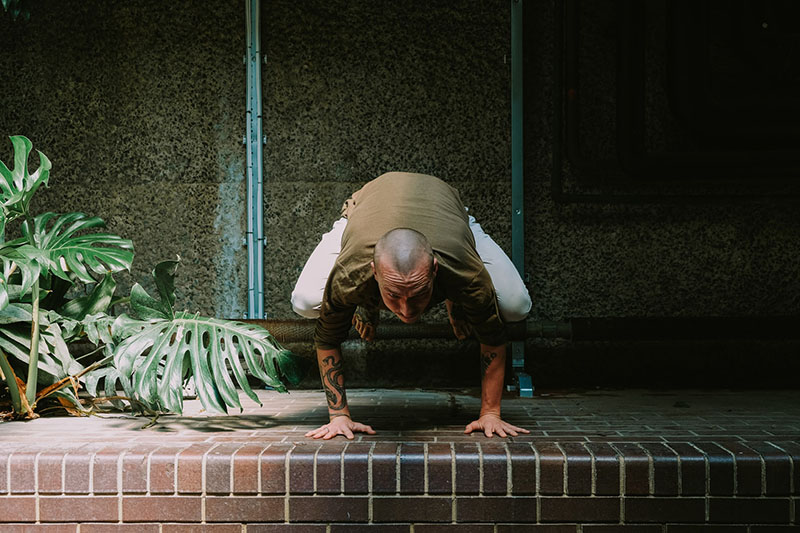
Finally, we enter the most challenging section of the Primary Series. These finishing poses are not for the faint of heart and are best learned under the guidance of a trained yoga instructor.
- Crow Pose and jumpbacks
- The Kona family of postures (3 in total)
- Upward Bow or Wheel Pose (Urdhva Dhanurasana)
- Paschimottanasana(for ten breaths)
- Shoulder Stand (Salamba Sarvangasana)
- Head Beyond the Knee Pose (Sirsasana B)
- Child’s Pose (Balasana)
- Lotus Pose (Padmasana)
- Corpse Pose (Savasana) – at last!
Part 7: Closing Mantra
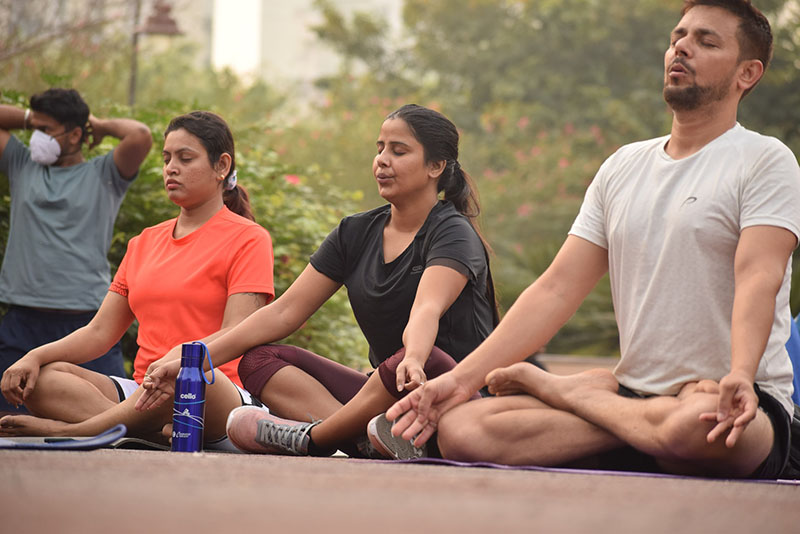
Some Ashtanga classes end with a closing chant or the classic “Namaste” salute.
Om
Svasti praja bhyaha pari pala yantam
(May the rulers of the earth keep to the path of virtue)
Nya yena margena mahi mahishaha
(for protecting the welfare of all generations)
Go brahmanebhyaha shubamastu nityam
(May the religions, and all peoples be forever blessed)
Loka samastah sukhino bhavantu
(May the whole of all the worlds be happy)
Om shanti shanti shanti
(Om, peace peace peace)
Key Takeaways: Ashtanga Primary Series
The main benefits of the Primary Series come from focus, release, lengthening, and strengthening every inch of your body. This series resets the body to allow work on a deeper level.
This time-tested sequence works every muscle and challenges the mind to prepare for the Intermediate Series and Advanced Series of Ashtanga. However, it can also be practiced on its own 3-5 times a week for mental and physical transformations.
Namaste!


